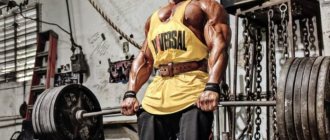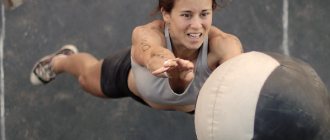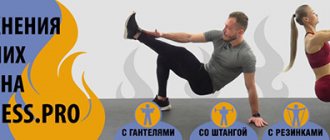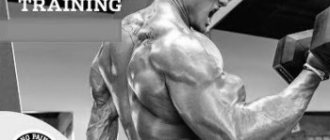March 9, 2020 Admin Home page » Training details
Many readers on the site, as well as in the official group in contact: Bomb body! Bodybuilding, fitness, aerobics!, they ask the same question, very often in articles you come across phrases - muscle failure and peak contraction, what is it?, they seem to guess, but are confused. So I decided to clearly describe what this means.
MUSCULAR FAILURE 3 is a situation in which it is impossible to complete a single repetition with the correct movement technique associated with both raising and lowering the weight at the very end of the exercise.
According to experiments and recorded scientific data, the best weight for developing lean body mass = 70% of maximum. Most people using this weight are able to perform 8-12 repetitions without breaking the movement technique.
If, when choosing the weight of the apparatus, 8 repetitions are not submissive for you, then the weight is too high, reduce it. If, on the contrary, you do more than 12 repetitions, the weight is too small, you should increase it.
It is weights in the region of 8-12 repetitions per 1 approach that can develop your muscles.
Athletes’ attitude towards failure and training postulates
Even before the golden age of bodybuilding, athletes were familiar with the phenomenon of failure and training programs using it, but in those days they tried to avoid failure. But time passes and the principles of training change, and modern bodybuilders simply cannot imagine high-quality training and large muscle volume without this amazing method.
Understanding the basic principles of training and recovery is essential to effectively building your body. Study the article on how to build muscles, and you will understand what happens to your body during and after training.
Bodybuilding is no different from many other areas, so it also has its own schools, along with theories and supporters/opponents of individual schools. There are two main directions, one of which says that the bulk of the mass is accumulated from small weights with a large number of repetitions and sets. On the other hand is Arthur Jones (who invented a trainer called the Nautilus). He claims that muscle growth occurs only with critical weights and a minimum number of sets and repetitions.
Proponents of heavy weights in training believed that the best results can be achieved only when even partial repetitions are impossible. The well-known expression “no pain – no gain” (without pain there is no growth) originates from this school.
For a long time there was conflict between these two schools over the validity of the concept. Let's think about what is the correct principle in training.
But first, let's remember two strong principles related to resistance training and muscle growth factors:
- the same type of load promotes only short-term growth;
- any physical activity provokes the growth of muscle tissue.
An example of how these points work in reality is noticeable among beginners, because in the first three months of training they actively transform. This is mainly due to the fact that before the start of training, the muscles did not experience any stress at all, and even improper training leads to muscle growth. But soon after this first phase of active transformation, a time comes when the results of the training are barely noticeable or disappear altogether.
If we consider the ideal scenario, then the training program should completely change. However, not everyone thinks so, so the issue is then solved in a trivial way - by raising the weight of the shells. The result is work without visible results, only the working weight gradually increases. It is important to understand that they have not yet come up with a universal training program that can always work. Progress is possible not only by increasing weight, but also by regularly changing types of loads.
Therefore, both directions in bodybuilding: small weights - many repetitions and large weights - few repetitions must be used. For example, alternate programs with these principles.
A well-designed training program taking into account the characteristics of your body and level of preparedness is the key to success in the gym. Find out how to properly create training programs yourself.
For refusal
Failure is an objective thing that we cannot influence, but we have techniques at our disposal, for example, forced repetitions and drop sets, through which we can overcome even this line. To perform forced reps, the trainee reaches failure and then, with the help of a spotter, continues the set. Drop sets, on the other hand, can be performed without the help of a partner. You simply continue with the exercise with a lighter weight after reaching failure with a higher load. In any case, your body is subjected to an even more intense load than with simple failure, which is both good and bad at the same time.
The benefits of forced reps and drop sets are similar to training to failure: more metabolic stress, more lactic acid, more muscle fiber recruitment. However, both techniques also provoke much more pronounced central fatigue than classical training to failure.5
With that said, and if you follow Joe Weider's principles in your training, I recommend that you only use these techniques at the end of a training session aimed at stimulating muscle growth. And be sure to make sure you have enough time to recover after your workout. This includes proper nutrition and adequate sleep. Parties and drinking do not go well with training to failure.
Muscle failure and its types
At one time, the Jones school attributed any progress in training only to failure, but even before a detailed analysis of this method, it is important to have a baggage of theory on this issue. If you look at scientific terminology, muscle failure is a condition that occurs when muscles become fatigued, when the athlete is simply physically unable to perform 1 repetition using the correct technique.
There are three types of failure:
- isometric (static) – weight retention;
- concentric (positive) – lifting the projectile;
- eccentric (negative) – lowering the weight.
The isometric type is an intermediate failure where two types of muscle fiber are involved. A phenomenon occurs when the glycogen depot and any reserves for obtaining “quick energy” run out. Based on research, the best gains in muscle growth, endurance, and strength using this type of failure are achieved with enough weight for 12-15 repetitions.
Concentric failure affects myofibrils (they are what causes muscles to increase in volume when they contract). The best results were observed when using weights of 4-6 repetitions.
As for eccentric failure, it develops the mitochondria. The main role of mitochondria is to produce the energy required for muscles, so failure occurs the moment any source of energy runs out. Using this type of failure helps build endurance, and the technique involves 20-25 repetitions with light weight.
Full and con[edit | edit code]
Complete “failure” is the inability of a person not only to lift or lower a weight, but even to hold it. Moreover, we are talking about the smallest weights. Complete “failure” is the maximum depletion of the nervous system and physical resources of the body, that is, a fairly serious illness. So when we talk about “failure” in relation to weight training, we mean the so-called failure, that is, the inability of a person to lift the weight. So, the con, which Mentzer considered muscular, is, in fact, a neurological phenomenon (damage to neurons occurs, and, as a result, there is an inability to transmit electromechanical impulses through them). The muscles calmly continue to work, which can be easily verified if, upon reaching “failure,” you lower the weight or switch exclusively to the negative phase of the movement.
Should you use opt-out in your program?
There are several arguments that speak about both the benefits and harms of using waivers. Therefore, now we will consider the main arguments “for”, and then we will evaluate why “against”.
Refusal is good, but only in one set
Even Mike Mentzer, a US bodybuilder who received the status of Vice-Mr. Olympia in 1979, put refusal training into practice and called it effective for building muscle mass. The only clarification is that failure should occur only in the last approach of the exercise performed. At the same time, he often turned a refusal repetition into a forced one - with outside help.
Additional stimulation of muscle tissue growth
Athletes often complete sets to failure, but in order to stimulate muscle growth, they need a serious load that destroys tissue and leads to microtrauma. This is precisely what contributes to muscle failure, “breaking through” stagnation. To achieve this effect, you need to immediately take the weight that leads to failure, and not the one with which you can comfortably perform 8-12 repetitions.
Anabolic hormones are produced during failure training
It has been proven that training with constant exposure to extreme load on the body increases endurance and provokes the secretion of a full list of anabolic hormones. And this already makes it possible to constantly increase the intensity of the courses.
But there is also a list of negative aspects of using programs that provide for the occurrence of muscle failure.
The lower the load, the higher the result
The criterion for pumping up a bodybuilder has always been constant muscle growth. In the long term, it is better to give up huge weights from the very beginning and increase your starting indicators gradually. As an example, if the bench press started with 50 kilograms, then by adding 2-3 kilograms monthly you will be able to reach even 100 kilograms. And this will already lead to an increase in muscle volume.
If you start with failure training, you will immediately have to take on an unbearable weight, so it will be difficult, and sometimes simply impossible, to achieve the same results. Large weight will prevent adequate recovery of the body, which means that such a program will not give muscle growth, but a “driven” body. If you believe scientific research, then mass growth occurs at a specific total load and does not depend on the specific weight of the projectiles. Conclusion acceptance with refusal is not for beginners.
CNS exhaustion
Lifting iron is always stressful, and if the weights are heavy, the load on the central nervous system is double. Constant failure reduces the level of sensitivity of the nerve endings located in the tendons. And this leads to a decrease in muscle strength and endurance.
Oxygen deficiency
Extreme loads to the point of failure provoke “oxygen starvation,” a situation when the concentration of oxygen in the blood decreases. As a result, oxygen is supplied by the blood in spurts and in unexpectedly large volumes, which leads to exhaustion and muscle breakdown.
Loss of balance of stabilizers
The muscle coordination required during the exercises becomes a victim of failure. Hard work in the gym will continue to occur with a high risk of unexpected failure of the stabilizer muscles. Additionally, the chances of developing a state of overtraining increase.
These are only the main factors obtained after thorough scientific research. Now you need to consider methods of achieving muscle failure if you plan to include it in your training program.
TOP 5 ways to achieve muscle failure
- The simplest method is to find a weight that allows you to technically perform 8-12 repetitions. For beginners, there is another option, because it is difficult for them to immediately choose the level of load. We just choose an approximate weight and do as many repetitions as we can do in compliance with the rules of technique.
- Chitting also allows you to “finish off” muscles. To do this, initially we work exclusively using the correct technique, and when we no longer have the strength, we lift the weight as best we can. This allows you to initially influence only the target muscle, and then “squeeze” the maximum, taking advantage of the capabilities of the assistant muscles.
- A superset based on the training principle from Joe Weider, which involves a series of different loads on one muscle without rest breaks. As an example, first load the quadriceps (leg extensions in the machine), and then squats with a barbell.
- Drop sets will require the participation of partners who will gradually reduce the load. As an example, let's take 100 kg of weight on a Smith machine (squats). We do repetitions until failure occurs, then we give commands to our partners, who throw off each pancake. We reach the point where there is an empty bar left, with which it is impossible to do a repetition.
- Help from a friend is also called a forced approach. The point is that in the process of implementing a certain number of repetitions, we then ask someone else for help and do another 2-3 repetitions. This allows you to better “finish off” the muscle.
“Rejection” deals a powerful blow to the nervous system[edit | edit code]
Moreover, both peripherally and centrally. It was said above that as a result, damage to neurons occurs, which results in the inability to transmit an electromechanical impulse through them. It takes quite a long time to restore the nervous system, sometimes this time exceeds 7-8 days. It doesn’t make much sense to train against a background of nervous system fatigue, that is, if you strictly follow the concept of “failure” training, you will have to take significant breaks between workouts. But many believe that the more often muscles are trained, the faster they grow.










